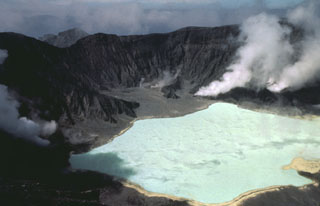Report on El Chichon (Mexico) — September 1986
Scientific Event Alert Network Bulletin, vol. 11, no. 9 (September 1986)
Managing Editor: Lindsay McClelland.
El Chichon (Mexico) Magnitude 3 earthquake nearby but crater unchanged
Please cite this report as:
Global Volcanism Program, 1986. Report on El Chichon (Mexico) (McClelland, L., ed.). Scientific Event Alert Network Bulletin, 11:9. Smithsonian Institution. https://doi.org/10.5479/si.GVP.SEAN198609-341120
El Chichon
Mexico
17.3602°N, 93.2297°W; summit elev. 1150 m
All times are local (unless otherwise noted)
A magnitude 3 earthquake centered 20 km NE of El Chichón occurred 28 September at 0956 GMT. Residents of Pichucalco (23 km NE of the volcano) and other nearby towns reported that they felt the earthquake. Geologists visited the volcano on 30 September. The crater interior and lake were essentially unchanged. Since November 1985, the crater lake water temperature has been 28.6°C, in equilibrium with the environment. Fumaroles in the N part of the crater had temperatures of about 97°C. No relationship between the earthquake and the volcano has been established.
Geological Summary. El Chichón is a small trachyandesitic tuff cone and lava dome complex in an isolated part of the Chiapas region in SE México. Prior to 1982, this relatively unknown volcano was heavily forested and of no greater height than adjacent non-volcanic peaks. The largest dome, the former summit of the volcano, was constructed within a 1.6 x 2 km summit crater created about 220,000 years ago. Two other large craters are located on the SW and SE flanks; a lava dome fills the SW crater, and an older dome is located on the NW flank. More than ten large explosive eruptions have occurred since the mid-Holocene. The powerful 1982 explosive eruptions of high-sulfur, anhydrite-bearing magma destroyed the summit lava dome and were accompanied by pyroclastic flows and surges that devastated an area extending about 8 km around the volcano. The eruptions created a new 1-km-wide, 300-m-deep crater that now contains an acidic crater lake.
Information Contacts: S. de la Cruz-Reyna, UNAM; J. Romeo León Vidal, Sismología del Sureste C. F. E., Tuxtla Gutierrez, Chiapas, México.

